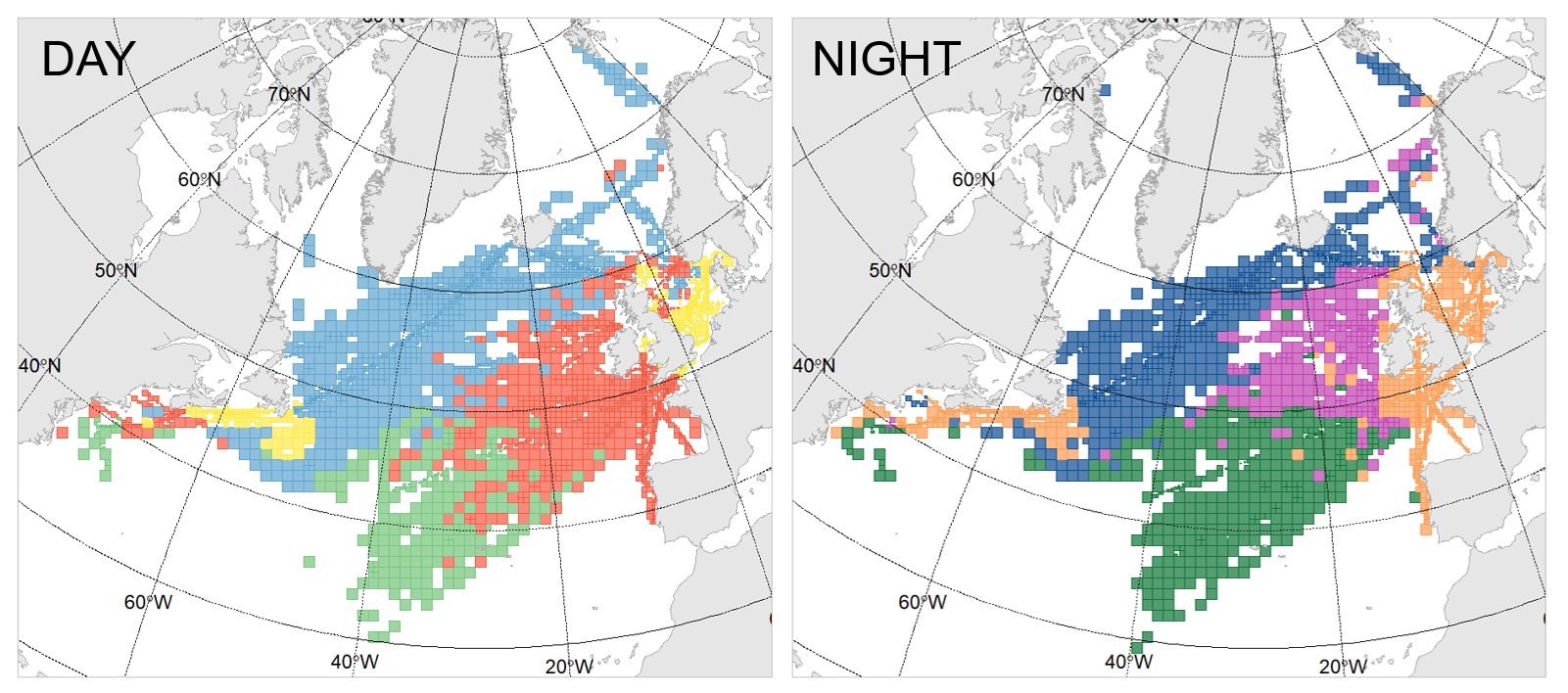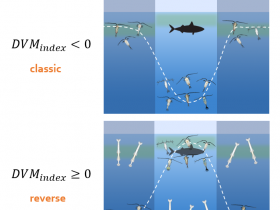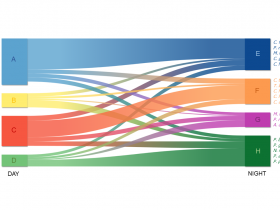Diel vertical migration shapes North Atlantic copepod bioregions
Diel vertical migration shapes North Atlantic copepod bioregions
Vilain, M., Goberville, E., Vincent, D., Benedetti, F., & Olivier, F. (2025). Diel Vertical Migration Shapes North Atlantic Copepod Bioregions. Journal of Biogeography. https://doi.org/10.1111/jbi.15120
Aim: Assessing the influence of diel vertical migration (DVM) on biogeographic patterns to improve the macroecological characterisation of the structure and function of zooplankton communities.
Location: North Atlantic Ocean and adjacent seas.
Taxon: Marine copepod species.
Methods: We base our bioregionalisation on Continuous Plankton Recorder (CPR) data of copepod species abundances from 1966 to 2021. We separate day and night samples using the solar elevation corresponding to civil twilight. For each condition, we interpolate abundances onto a grid adapted to the irregular sampling effort. We then generate a bipartite network (geographical cells – species) on which we apply the Map Equation clustering algorithm to delineate bioregions and identify their underlying copepod communities. We use canonical correspondence analyses to characterise the resulting bioregions in terms of environmental forcings, species composition, and community-weighted mean traits.
Results: We identify four bioregions for both day and night partitions, with dynamic transitions and changes in spatial patterns as well as in community composition between day and night. While environmental forcings seem to transcend diel variations, ecological features of bioregions show day/night discrepancies: higher copepod diversity at night is driven by changes in species composition mediated by diel vertical migration.
Main conclusions: We highlight how day/night variations driven by highly migratory copepod species shape community spatial patterns and species composition. We uncover distinct levels of functional diversity across bioregions, suggesting different responses of copepod communities to environmental changes. Transition zones emerge as crucial markers of pelagic bioregion connectivity, emphasising their dynamic nature. Embracing a partitioning approach which better captures these dynamics is essential for understanding how ecosystems function and will evolve in response to climate changes.
Keywords: Biogeography, Continuous Plankton Recorder, Copepod communities, DVM, Functional traits, Network clustering, Zooplankton macroecology
Aim: Assessing the influence of diel vertical migration (DVM) on biogeographic patterns to improve the macroecological characterisation of the structure and function of zooplankton communities.
Location: North Atlantic Ocean and adjacent seas.
Taxon: Marine copepod species.
Methods: We base our bioregionalisation on Continuous Plankton Recorder (CPR) data of copepod species abundances from 1966 to 2021. We separate day and night samples using the solar elevation corresponding to civil twilight. For each condition, we interpolate abundances onto a grid adapted to the irregular sampling effort. We then generate a bipartite network (geographical cells – species) on which we apply the Map Equation clustering algorithm to delineate bioregions and identify their underlying copepod communities. We use canonical correspondence analyses to characterise the resulting bioregions in terms of environmental forcings, species composition, and community-weighted mean traits.
Results: We identify four bioregions for both day and night partitions, with dynamic transitions and changes in spatial patterns as well as in community composition between day and night. While environmental forcings seem to transcend diel variations, ecological features of bioregions show day/night discrepancies: higher copepod diversity at night is driven by changes in species composition mediated by diel vertical migration.
Main conclusions: We highlight how day/night variations driven by highly migratory copepod species shape community spatial patterns and species composition. We uncover distinct levels of functional diversity across bioregions, suggesting different responses of copepod communities to environmental changes. Transition zones emerge as crucial markers of pelagic bioregion connectivity, emphasising their dynamic nature. Embracing a partitioning approach which better captures these dynamics is essential for understanding how ecosystems function and will evolve in response to climate changes.
Keywords: Biogeography, Continuous Plankton Recorder, Copepod communities, DVM, Functional traits, Network clustering, Zooplankton macroecology
BOREA contact:
- Eric Goberville, eric.goberville@mnhn.fr
- Frédéric Olivier, frederic.olivier@mnhn.fr




